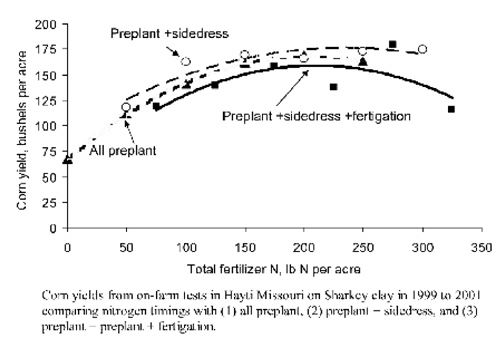Fertility Management For Continuous Corn
Corn prices and yields were much higher in 2007 than previous years. However, input costs, especially nitrogen fertilizer, took a big bite out of farm profits. As I write this article,urea is $445 per ton or 48 cents per pound of N.Since wheat planting is up this fall, more soybean and fewer corn acres will probably be planted next year. That could ease demand on N and bring fertilizer prices down in the spring.But we also thought that N prices would go down last spring and they kept going up. If you plant corn, you need to make every pound of N count.From 1999 to 2001, we conducted irrigated corn nitrogen experiments on farmer fields in Hayti ,Caruthersville, and Charleston, Missouri to determine whether splitting nitrogen applications would increase corn yields and reduce the optimum N rate needed. We also looked at methods for detecting nitrogen deficiency stress in corn plants for making fertigation decisions.
The study investigated the use of aerial image remote sensing and hand-held chlorophyll meter to develop in-field nitrogen tests for predicting response to fertigation and to detect spatially variable corn N needs for developing variable rate fertilizer maps. In Southeast Missouri, approximately 60% of corn acreage is center pivot irrigated. By adding fertilizer injection pumps and backflow prevention equipment to center pivots, farmers can apply N as needed with irrigation to correct N stress.
Tissue sampling and analysis for nitrogen has traditionally been the method for monitoring corn N status. Chlorophyll meters have been promoted as a quick and reliable tool to monitor N status of crops. A portable instrument developed by the Soil-Plant Analyses Development(SPAD) unit of Minolta Camera is available commercially for estimating chlorophyll in corn plants. During the past decade, scientists have been testing and calibrating the meter for specific crops and regions. However, the meter has largely remained a research tool due to a lack of exposure, the lack of recommendations, and the expense of purchasing the meter.
Soil samples were collected before planting to measure residual N. A range of nitrogen sufficiency was established by applying five rates of ammonium nitrate at planting. Additional fertilizer was applied by fertigation to some treatments at V7 and at V12 corn growth stages.
Delaying some nitrogen application until corn gets waist-high and pre-tassel growth stages is an insurance policy against potentially losing N in an extended early rainy period. But in an average growing season, fertigating nitrogen may not be necessary for achieving top corn yields.Over the three years of our experiments, we did not have excessive spring rain conditions which would cause standing water in fields promoting denitrification or leaching N losses. Yield results showed that optimum corn yields were achieved with a total of 175 to 180 lb N per acre regardless of how it was applied.
Nitrogen fertilizer applied all preplant was not significantly different from the same rate applied in multiple splits. We also learned that aerial photography and hand-held Minolta chlorophyll meters are effective tools for detecting N stress.Chlorophyll meter reading values increase proportional to the “greenness” of the leaves. We found that plots with meter readings higher than 55.0 did not show a yield response to 25 lb N applied by fertigation at V12 growth stage. Since corn varieties naturally vary in their shades of green, we strongly encourage farmers to establish a high N reference strip in each field when using chlorophyll meters or aerial remote sensing for nitrogen management. Also, high N references help prevent incorrectly applying more N trying to correct a yellow color in leaves caused by something other than N deficiency.
To determine the most profitable nitrogen rate for specific corn and fertilizer prices, use NI-TROMAX software. It can be downloaded for a free copy, go to www.plantsci.missouri.edu/deltacrops. ∆
